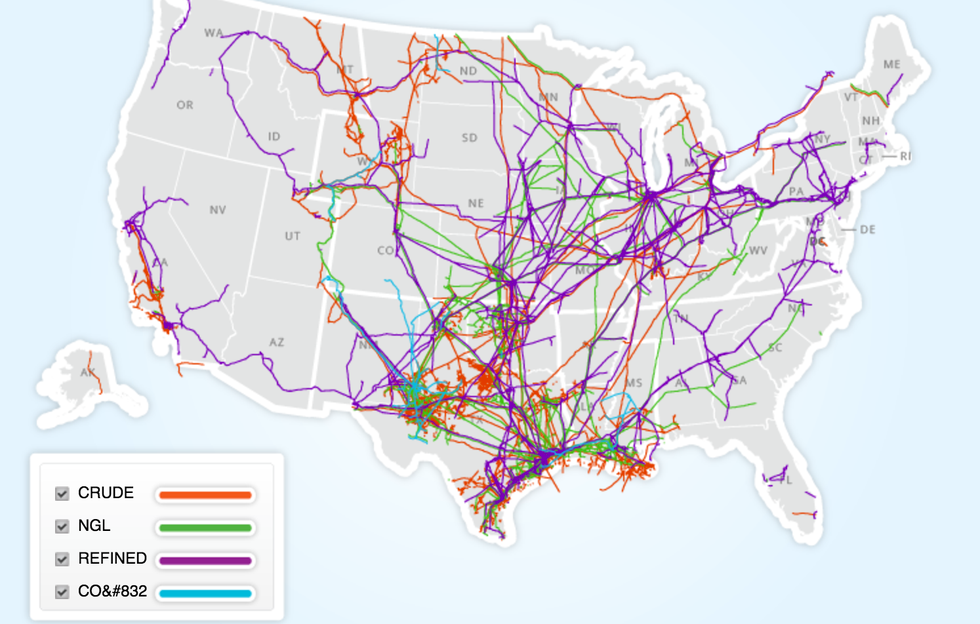Many people have explained the Dakota Access Pipeline controversy as a protest that has less to do with an actual pipeline, and is instead rooted deeper in cultural issues between Native Americans and non-natives. The following facts explain why the construction of the pipeline may not have been as devastating as some people thought it would be:
1. There are over 2.4 million miles of gas and oil pipelines across the U.S.
The Dakota Access Pipeline Fact Sheet explains that over 70% of crude oil used in the United States is transported through pipelines that are used every day. “The extensive pipeline network is heavily regulated by the U.S. Department of Transportation for both safety and reliability and has been proven to be the safest, most efficient means of transporting energy resources.”
2. The Army Corps of Engineers held 389 meetings with 55 Native American tribes.
Orlando Sentinel explains, “The [Army] Corps alerted the tribe to the pipeline permit application in the fall of 2014 and repeatedly requested comments from and meetings with tribal leaders only to be rebuffed over and over. Tribal leaders ignored requests for comment and canceled meetings multiple times. In September 2014 alone, the corps made 5 unsuccessful attempts to meet with Standing Rock Sioux leaders. The next month, a meeting was arranged, but ‘when the Corps timely arrived for the meeting, Tribal Chairman David Archambault told them that the conclave had started earlier than planned and had already ended,’ according to a federal judge. At a planned meeting the next month, the tribe took the pipeline off the agenda and refused to discuss it. This stonewalling by tribal leaders continued for a year and a half… ‘The court record reveals that the Standing Rock Sioux refused to meet with corps officials to discuss the route until after site work had begun. That work is now 77 percent completed at a cost of $3 billion.”
3. There is already another pipeline in place parallel to where the Dakota Access Pipeline would have been built.
The Northern Border Pipeline was built in 1983 and runs from Montana to Indiana. According to the owner of the pipeline, TCPipelines LP, it “is a key link in the transportation of natural gas supply from the Western Canadian Sedimentary Basin to a growing U.S. Midwest market.”
4. Just like the Northern Border Pipeline, the Dakota Access Pipeline would not actually run through on sacred Native American land.
The controversy of this issue comes from the idea that if a pipeline was built near Standing Rock Reservation, an unexpected burst may pollute the water of that area. Some people, however, believe the protests were initiated by the construction of a pipeline through the Standing Rock reservation, which is factually inaccurate. As Standing Rock Fact-Checker states, “If the aim was to defend the water on the Missouri, or ambiguous ‘Tribal Lands’ from the incursions of pipeline corporations, the war was lost back in 1983 with the construction of another pipeline. It should also be noted that neither Northern Border, nor Dakota Access will cross into the Standing Rock Sioux Tribe Reservation.”
5. The Dakota Access Pipeline would be beneficial for U.S. oil companies and workers.
Pipelines create fewer oil spills than when oil is transported by truck or train. U.S. oil is also imported from about 88 countries, which complicates our access to the energy we need to survive in terms of both safety and economic efficiency. According to the Dakota Access Pipeline Fact Sheet, the pipeline is a “$3.78 million-dollar investment that would create 8,000 to 12,000 jobs during construction. Millions of hours of labor will be needed during the construction phase, putting welders, mechanics, electricians, pipefitters, heavy equipment operators and others within the heavy construction industry to work. There will also be increased demand for those who manufacture [the parts used to make the pipeline].” They go on to list other ways the pipeline with help communities as wholes: “The pipeline will translate into millions in state and local revenues during the construction phase and an estimated $156 in sales and income taxes. The pipeline will generate an estimated $55 million annually in property taxes to the states of North Dakota, South Dakota, Iowa, and Illinois. These tax dollars can be used to support schools, hospitals, emergency services, and other critical long-term needs.
6. Failure to continue construction of the pipeline has led to significant economic loss, especially in North Dakota.
According to the New York Times, "Energy Transfer Partners, a major pipeline operator, has lost hundreds of millions of dollars from delays in the completion of the Dakota Access Pipeline. And its standoff with the Standing Rock Sioux Tribe over a section running through tribal lands could mean an additional $80 million a month in losses. But it is not the only one paying the price. For North Dakota’s oil producers, once riding high on production from the booming Bakken fields, it is a new blow, after the plunge in oil prices that has shifted the industry’s activity and focus back to more traditional oil regions.”
7. The Standing Rock Sioux tribe’s main water source is twenty miles away from where the pipeline was to be built.
Reuters explains the facts: “For months, North Dakota's Standing Rock Sioux tribe has been protesting the Dakota Access Pipeline's planned crossing under the Missouri River, adjacent to their lands, in part due to worries about contamination of their primary water source. As of early next year, however, the Native American tribe will be gathering their water 70 miles (113 km) downstream of the oil pipeline's location, thanks to a long-awaited water treatment plant. The reservation, which spans North and South Dakota, currently gets water 20 miles away from the pipeline's planned location. While the scope of contamination of a future oil leak is difficult to predict, the distance from the pipeline to the new intake could reduce widespread contamination risks, regulators and environmental analysts said.”
8. The original route for the pipeline was changed due to concern over contamination of water supply and destruction of sacred sites.
The Corp’s Environmental Assessment states that the North Bismarck route “was in proximity to and/or crossing multiple conservation easements, habitat management areas, National Wildlife Refuges, state trust lands, waterfowl production areas, and private tribal lands,” which is why it was rerouted.
An article published by The Conversation explains, "In North Dakota, federal and state review and compliance measures for DAPL were combined. Archaeologists walked the pipeline’s 357 miles in North Dakota, locating 149 sites potentially eligible for the National Register of Historic Places. Engineers rerouted DAPL to avoid all but nine sites."
Additionally, The Dakota Access Pipeline Fact Sheet has listed the multiple ways in which they had researched ways to avoid water contamination and destruction of land: “Where possible, the pipeline will parallel existing pipelines, power lines, or existing roads. During construction, an additional 50–100 feet of workspace is needed adjacent to the permanent 50-foot right-of-way. The pipeline is covered by a minimum of 36 inches of soil and more if it crosses under roads, rivers, lakes, or streams. In agricultural fields, the pipe will be placed under a minimum of 48 inches of soil... In consolidated rock, the pipeline will be buried a minimum of 24 inches and elsewhere a minimum of 36 inches...A specific agricultural-crossing plan is being developed, which will be approved by applicable state agencies, and will be presented to each landowner for use or comment. Each agricultural field will be crossed in accordance with a specific crossing plan with each landowner in accordance with the overall plan.”
9. Photography was not permitted unless journalists were accompanied by an escort.
What pictures haven't been taken?

























